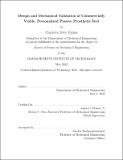Design and Mechanical Validation of Commercially Viable, Personalized Passive Prosthetic Feet
Author(s)
Folinus, Charlotte Méry
DownloadThesis PDF (15.57Mb)
Advisor
Winter V, Amos G.
Terms of use
Metadata
Show full item recordAbstract
Existing energy storage and return (ESR) prosthetic feet are available in a low-resolution and discrete set of size and stiffness options. While these devices are reimbursed for thousands of dollars through insurance, the current low-resolution sizing systems may limit the walking performance of many amputees. The design, manufacturing, and provision processes used to create existing prosthetic feet are inherently low resolution; providing amputee-specific personalization with these methods is either not possible or not commercially viable. The Lower Leg Trajectory Error (LLTE) design framework provides an oportunity for designing high-performance, amputee-specific prosthetic feet; however, previous foot prototypes were designed as experimental prototypes to demonstrate the LLTE theory, not to satisfy the economic, mechanical, and aesthetic requirements necessary for commercial adoption.
This thesis aims to understand how a personalized, affordable prothetic foot can be realized for a clinical-commercial setting. First, we evaluate stakeholder needs and identify the flows of products, capital, and services between prosthetics suppliers, distributors, prosthetists, amputees, and insurance providers. We elucidate the design requirements for a personalized prosthetic foot that can be manufactured, distributed, and clinically provided by Hanger, a current leader in both product distribution and patient care in orthotics and prosthetics.
Based on material properties and manufacturing process capabilities, we demonstrate why CNC machining of Nylon 6/6 is an appropriate process for satisfying these requirements. Although additive manufacturing is often seen as a compelling method for creating customized products, additively manufactured ESR prosthetic feet would likely have inferior walking performance, take longer to produce, cost more, and experience greater manufacturing variability than CNC machined feet. Next, this thesis presents a novel parametric foot architecture that can be CNC machined, fits within a commercial foot shell, and can be designed for individual users’ body characteristics and activity levels. Lastly, we demonstrate that prototypes made using the upgraded foot design mechanically behave as anticipated and satisfy industry-standard strength and mechanical performance requirements.
Date issued
2022-05Department
Massachusetts Institute of Technology. Department of Mechanical EngineeringPublisher
Massachusetts Institute of Technology